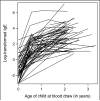Effect of prenatal indoor pet exposure on the trajectory of total IgE levels in early childhood
- PMID: 21820714
- PMCID: PMC3185205
- DOI: 10.1016/j.jaci.2011.06.039
Effect of prenatal indoor pet exposure on the trajectory of total IgE levels in early childhood
Abstract
Background: The presence of pets in a home during the prenatal period and during early infancy has been associated with a lower prevalence of allergic sensitization and total IgE levels in middle childhood. No studies have examined the effect of pet exposure in a population-based cohort by using multiple early-life measures of serum total IgE.
Objective: We sought to examine within-individual longitudinal trends in total IgE levels during early childhood and assess the effect of indoor prenatal pet exposure on those trends. Also, we sought to use a statistical method that was flexible enough to allow and account for unequally spaced study contacts and missing data.
Methods: Using the population-based Wayne County Health, Environment, Allergy and Asthma Longitudinal Study birth cohort (62% African American), we analyzed 1187 infants with 1 to 4 measurements of total IgE collected from birth to 2 years of age. Effects of pet exposure on the shape and trajectory of IgE levels were assessed by using a multilevel longitudinal model, accommodating repeated measures, missing data, and the precise time points of data collection.
Results: The best-fit shape to the trajectory of IgE levels was nonlinear, with an accelerated increase before 6 months. Total IgE levels were lower across the entire early-life period when there was prenatal indoor pet exposure (P < .001). This effect was statistically significantly stronger in children delivered by means of cesarean section versus those delivered vaginally (P < .001 and P < .06, respectively) and in those born to non-African American (P < .001) versus African American (P < .3) mothers.
Conclusion: Pet exposure and delivery mode might be markers of infant exposure to distinct microbiomes. The effect of exposures might vary by race, suggesting a differential effect by ancestry.
Copyright © 2011 American Academy of Allergy, Asthma & Immunology. Published by Mosby, Inc. All rights reserved.
Figures


Similar articles
-
Indoor pet exposure and the outcomes of total IgE and sensitization at age 18 years.J Allergy Clin Immunol. 2010 Aug;126(2):274-9, 279.e1-5. doi: 10.1016/j.jaci.2010.05.001. Epub 2010 Jun 25. J Allergy Clin Immunol. 2010. PMID: 20579718 Free PMC article. Clinical Trial.
-
Subgroup differences in the associations between dog exposure during the first year of life and early life allergic outcomes.Clin Exp Allergy. 2017 Jan;47(1):97-105. doi: 10.1111/cea.12804. Epub 2016 Oct 10. Clin Exp Allergy. 2017. PMID: 27562398 Free PMC article.
-
What are the main environmental exposures associated with elevated IgE in Cuban infants? A population-based study.Trop Med Int Health. 2014 May;19(5):545-54. doi: 10.1111/tmi.12293. Epub 2014 Mar 28. Trop Med Int Health. 2014. PMID: 24674274 Free PMC article.
-
Prevention of allergic disease in childhood: clinical and epidemiological aspects of primary and secondary allergy prevention.Pediatr Allergy Immunol. 2004 Jun;15 Suppl 16:4-5, 9-32. doi: 10.1111/j.1399-3038.2004.0148b.x. Pediatr Allergy Immunol. 2004. PMID: 15125698 Review.
-
Prenatal Factors in the Development of Allergic Diseases.Int J Mol Sci. 2024 Jun 8;25(12):6359. doi: 10.3390/ijms25126359. Int J Mol Sci. 2024. PMID: 38928067 Free PMC article. Review.
Cited by
-
Allergic sensitization frequency and wheezing differences in early life between black and white children.Allergy Asthma Proc. 2012 Nov-Dec;33(6):493-9. doi: 10.2500/aap.2012.33.3600. Allergy Asthma Proc. 2012. PMID: 23394507 Free PMC article.
-
The Phenotype of the Food-Allergic Patient.Immunol Allergy Clin North Am. 2021 May;41(2):165-175. doi: 10.1016/j.iac.2021.01.001. Epub 2021 Mar 26. Immunol Allergy Clin North Am. 2021. PMID: 33863477 Free PMC article. Review.
-
Microbial Sharing between Pediatric Patients and Therapy Dogs during Hospital Animal-Assisted Intervention Programs.Microorganisms. 2021 May 13;9(5):1054. doi: 10.3390/microorganisms9051054. Microorganisms. 2021. PMID: 34068292 Free PMC article.
-
Exposure to household furry pets influences the gut microbiota of infant at 3-4 months following various birth scenarios.Microbiome. 2017 Apr 6;5(1):40. doi: 10.1186/s40168-017-0254-x. Microbiome. 2017. PMID: 28381231 Free PMC article.
-
Replenishing our defensive microbes.Bioessays. 2013 Sep;35(9):810-7. doi: 10.1002/bies.201300018. Epub 2013 Jul 8. Bioessays. 2013. PMID: 23836415 Free PMC article. Review.
References
-
- Arbes SJ, Jr., Gergen PJ, Elliott L, Zeldin DC. Prevalences of positive skin test responses to 10 common allergens in the US population: Results from the Third National Health and Nutrition Examination Survey. J Allergy Clin Immunol. 2005;116:377–383. - PubMed
-
- McNeill G, Tagiyeva N, Aucott L, Russell G, Helms PJ. Changes in the prevalence of asthma, eczema and hay fever in pre-pubertal children: a 40-year perspective. Paediatr Perinat Epidemiol. 2009;23:506–512. - PubMed
Publication types
MeSH terms
Substances
Grants and funding
LinkOut - more resources
Full Text Sources
Other Literature Sources
Medical

